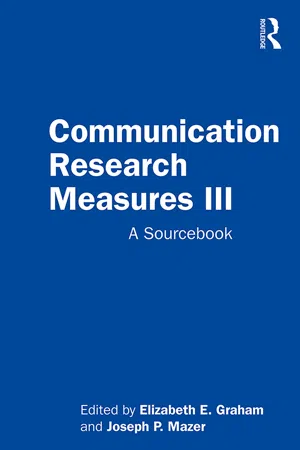
Communication Research Measures III
A Sourcebook
- 528 pages
- English
- ePUB (mobile friendly)
- Available on iOS & Android
Communication Research Measures III
A Sourcebook
About This Book
Building on the measures included in the original 1994 volume and subsequent 2009 volume, Communication Research Measures III: A Sourcebook extends its coverage of measurement issues and trends across the entire communication discipline.
Volume III features entirely new content and offers an assessment of new measures in mass, interpersonal, instructional, group, organizational, family, health, and intercultural communication and highlights work in emergent subdisciplines in communication, including social media and new communication technologies, sports communication, and public relations. The "best of the best" from 2009 through today, the profiled research measures in Volume III serve as models for future scale development and constitute the main tools that researchers can use for self-administered measurement of people's attitudes, conceptions of themselves, and perceptions of others.
This book is ideal for undergraduate and graduate courses that emphasize quantitative research methods, measurement, and/or survey design across communication studies disciplines.
Frequently asked questions
Information
Part I
Measurement Trends and Issues
Measurement in Interpersonal Communication
Identification and Inclusion Process
| NAME OF SCALE | CONCEPT/FOCUS | AUTHOR(S) | JOURNAL |
|---|---|---|---|
| *Active-Empathic Listening Scale (AELS) | Active-empathic listening – self and other measure | Bodie, G. D. | Communication Quarterly, 59, 277–295 |
| Arguing Goals Scale | General arguing goals during interactions | Cionea, I. A., Hoelscher, C. S., & Iles, I. A. | Communication Reports, 30, 51–65 |
| *Blurting Scale | Spontaneous and unedited speech | Hample, D., Richards, A. S., & Skubisz, C. | Communication Monographs, 80, 503–532 |
| *Communication Anxiety Regulation Scale (CARS) | Emotion regulation strategies to manage acute communication anxiety | White, K. H., Howard, M. C., Zhong, B., Soto, J. A., Perez, C. R., Lee, E. A., Dawson-Andoh, N. A., & Minnick, M. R. | Communication Quarterly, 63, 23–43 |
| Communication Based Emotional Support Scale (CBESS) | Emotional support | Weber, K., Johnson, A., & Corrigan, M. | Communication Research Reports, 21, 316–323 |
| *Communicative Responses to Jealousy (CRJ) scale – revised | Jealousy | Guerrero, L. K., Hannawa, A. F., & Babin, E. A. | Communication Methods & Measures, 5, 223–249 |
| Dogmatism Scale | Open- or closed-mindedness | Shearman, S. M., & Levine, T. R. | Communication Quarterly, 54, 275–291 |
| First-Date Goals Index | Social and relational goals for first dates | Mongeau, P. A., Serewicz, M. C. M., & Therrien, L. F. | Communication Monographs, 71, 121–147 |
| Lie Acceptability | Attitudes about deceptive communication | Oliveira, C. M., & Levine, T. R. | Communication Research Reports, 25, 282–288 |
| Narrative Believability Scale (NBS-12) | Acceptance of narratives as true | Yale, R. N. | Journal of Communication, 63, 578–599 |
| Nonverbal Immediacy Scale (NIS) | Nonverbal immediacy – self and other measure | Richmond, V. P., McCroskey, J. C., & Johnson, A. D. | Communication Quarterly, 51, 504–517 |
| Provider Expressions of Verbal Person-Centeredness (PE-VPC) scale | Verbal person-centeredness, supportive messages | Harvey-Knowles, J. & Faw, M. | Communication Reports, 29, 35–49 |
| *Relational Entitlement and Proprietariness (REP) scale | Viewing and treating romantic partners as property | Hannawa, A. F., & Spitzberg, B. H. | Communication Methods & Measures, 5, 1–27 |
| *Relational Maintenance Behavior Measure (RMBM) | Relationship maintenance | Stafford, L. | Journal of Social and Personal Relationships, 28, 278–303 |
| *Relational Maintenance Communication Scale (RMCS) | Relationship maintenance | Ledbetter, A. M. | Southern Communication Journal, 78, 289–310 |
| *Romantic Partner Conflict Scale (RPCS) | Relationship conflict | Zacchilli, T. L., Hendrick, C., & Hendrick, S. S. | Journal of Social and Personal Relationships, 26, 1073–1096 |
| State Empathy Scale | Empathy during message processing | Shen, L. | Western Journal of Communication, 74, 504–524 |
| Verbal Rumination (VR) measure | Repetitive speech | Henson, D. F. | Communication Journal of New Zealand, 10, 1–25 |
| *Weak-Tie/Strong-Tie Scale (W/STS) | Social support network preference | Wright, K. B., & Miller, C. H. | Communication Monographs, 77, 500–517 |
| *Willingness to Self-Censor Scale (WTSCS) | Individual expression given public opinion | Hayes, A. F., Uldall, B. R., & Glynn, C. J. | Communication Methods & Measures, 4, 256–272 |
Evolving Discipline and Interpersonal Communication Measurement
Measurement Considerations
Conceptual Definitions, Theoretical Issues, and Operational Definitions
Table of contents
- Cover
- Half Title
- Series Page
- Title Page
- Copyright Page
- Dedication
- Table of Contents
- Editors and Contributors
- Preface
- Acknowledgments
- Introduction
- Part I: MEASUREMENT TRENDS AND ISSUES
- Part II: MEASURE PROFILES
- Author Index
- Subject Index